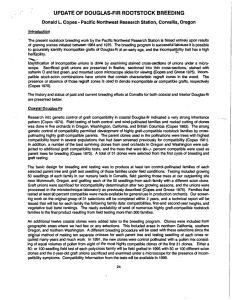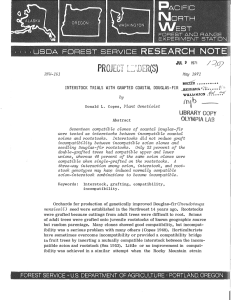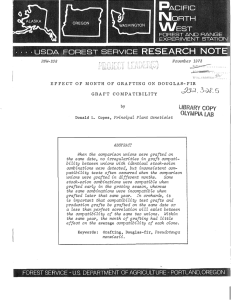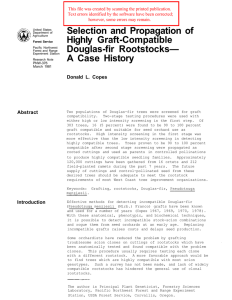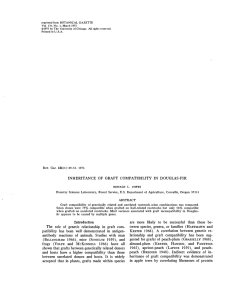Seed Source ancl Gralt Compatibility ... Note by Donald Copes
advertisement
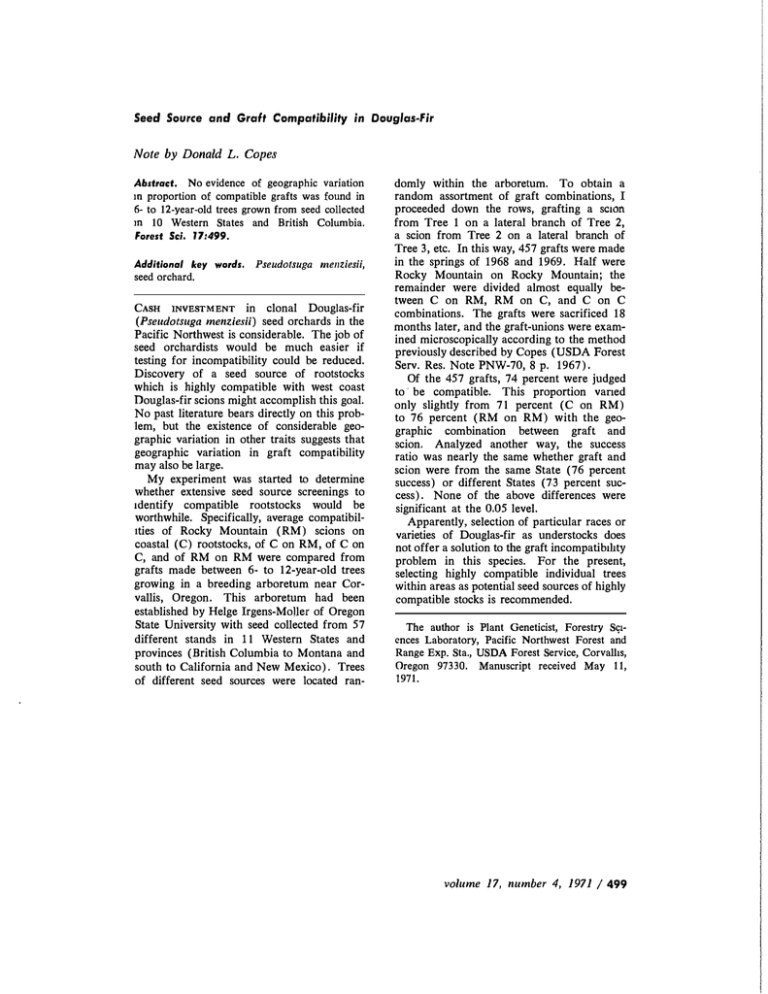
Seed Source ancl Gralt Compatibility in Douglas-Fir Note by Donald L. Copes Abstract. m No evidence of geographic variation proportion of compatible grafts was found in 6- to 12-year-old trees grown from seed collected m 10 Western States and British Columbia. Forest Sc:i. 17:499. Additional key words. Pseudotsuga menziesii, seed orchard. CASH INVESTMENT in clonal Douglas-fir (Pseudotsuga menziesii) seed orchards in the Pacific Northwest is considerable. The job of seed orchardists would be much easier if testing for incompatibility could be reduced. Discovery of a seed source of rootstocks which is highly compatible with west coast Douglas-fir scions might accomplish this goal. No past literature bears directly on this prob­ lem, but the existence of considerable geo­ graphic variation in other traits suggests that geographic variation in graft compatibility may also be large. My experiment was started to determine whether extensive seed source screenings to tdentify compatible rootstocks would be worthwhile. Specifically, average compatibil­ Ities of Rocky Mountain (RM) scions on coastal (C) rootstocks, of C on RM, of C on C, and of RM on RM were compared from grafts made between 6- to 12-year-old trees growing in a breeding arboretum near Cor­ vallis, Oregon. This arboretum had been domly within the arboretum. To obtain a random assortment of graft combinations, I proceeded down the rows, grafting a seton from Tree 1 on a lateral branch of Tree 2, a scion from Tree 2 on a lateral branch of Tree 3, etc. In this way, 457 grafts were made in the springs of 1968 and 1969. Half were Rocky Mountain on Rocky Mountain; the remainder were divided almost equally be­ tween C on RM, RM on C, and C on C combinations. The grafts were sacrificed 18 months later, and the graft-unions were exam­ ined microscopically according to the method previously described by Copes (USDA Forest Serv. Res. Note PNW-70, 8 p. 1967). Of the 457 grafts, 74 percent were judged to· be compatible. This proportion vaned only slightly from 71 percent (C on RM) to 76 percent (RM on RM) with the geo­ graphic combination between graft and scion. Analyzed another way, the success ratio was nearly the same whether graft and scion were from the same State (76 percent . percent suc­ success) or different States (73 cess). None of the above differences were significant at the 0.05 level. Apparently, selection of particular races or varieties of Douglas-fir as understocks does not offer a solution to the graft incompatibthty problem in this species. For the present, selecting highly compatible individual trees within areas as potential seed sources of highly compatible stocks is recommended. established by Helge Irgens-Moller of Oregon State University with seed collected from 57 The author is Plant Geneticist, Forestry Sci­ different stands in 11 Western States and ences Laboratory, Pacific Northwest Forest and provinces (British Columbia to Montana and Range Exp. Sta., USDA Forest Service, Corvalhs, south to California and New Mexico). Trees Oregon 97330, of different seed sources were located ran­ 1971. Manuscript received May 11, volume 17, number 4, 1971 I 499







